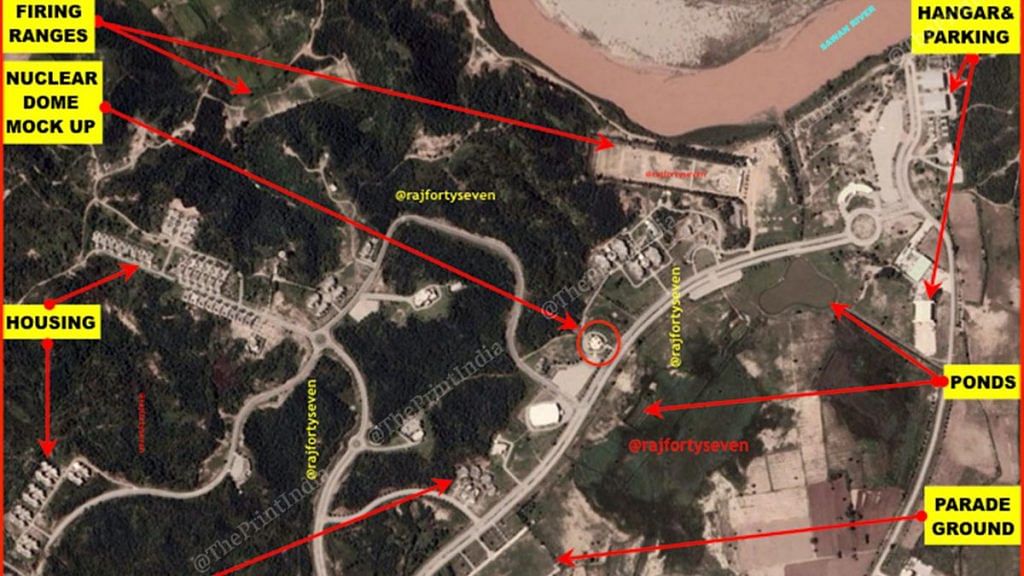New Delhi: The international community has been worried about the security of Pakistan’s nuclear arsenal for years now, even though the country’s politicians, military and nuclear experts insist that the weapons are safe and secure.
Satellite imagery has revealed that Pakistan has built a facility near capital Islamabad and military headquarters Rawalpindi that provides specialised training to guards and commandos to ensure the safety and security of the country’s nuclear facilities.
ThePrint takes an in-depth look.
Also read: Pakistan Navy’s nuke storage facility at Arabian Sea port of Ormara sees massive expansion
Location and subjects taught
Pakistan’s Centre of Excellence and Nuclear Security (PCENS) is located at Chakri, about 50 km south-west of Islamabad on the eastern bank of the river Sawan.
The PCENS, originally called the Training Academy of Strategic Plans Division (SPD), was established in 2012, the only such institution in the country. It has already been expanded twice, in 2016 and 2018.
The facilities in this institution replicate the environment of a nuclear power plant, production centres and storage units, including ammunition depots, elsewhere in Pakistan.
SPD personnel are taught physical protection, material safety, accountability, control and operating procedures. Cyber security and personnel evaluation, both active and passive, are also part of the syllabus.
Outsider threats
Satellite images indicate that the personnel are routinely trained to counter outsider threats like attacks, raids, capture of a facility or part thereof, and other security breaches.
Special ponds have been created to train personnel on water-borne attacks or raids. The ponds cater to two types of contingencies — through flowing water and stagnant water.
There are two firing ranges, one of which is 300m long and the other 250m. The larger firing range has a slithering and rappelling building, which acts as a mock-up for a helicopter.
There is also a complete obstacle course with all kinds of blocks for ensuring fitness. A number of covered squad posts cater for field-training exercises.
A large hangar probably holds helicopter(s) during temporary halts for hands-on training and/or display for VIP visits. At least six helipads that cater for training and VIP requirements are observed.
There is also a parade ground for drills, while a small motor track has been created for specialised vehicle training.
An area has been possibly earmarked for training on tunnelled facilities. The tunnels have been created with small openings to simulate real surroundings.
The satellite images indicate that subjects like waste disposal, security management and security of launch pads for road-mobile tractor erector launchers (TELs) are also being given adequate coverage.
New, stagnant water ponds observed on the images could have a small submarine environment created for training on any nuclear submarine emergency at a later date.
Insider threats
‘Insider threat’ refers to sabotage, theft of nuclear material or knowhow, technical books and manuals as well as cyber security. Subversion would also be covered.
The integrated physical security systems could become compromised to provide access to an outsider very easily. Different types of physical security arrangements are observed on satellite images, along with typical systems seen at most nuclear locations in Pakistan.
A circular, dome-shaped building with a large chimney creates the exact environment of the hot area of a nuclear power plant. Various contingencies related to the threat perceived inside a nuclear plant dome would be taught at this location.
Personnel verification programmes are taught and various contingencies are studied in these labs.
Administrative facilities
The PCENS has adequate administrative buildings for running the institution and its facilities. There are living accommodations for officers, junior commissioned officers and other ranks (JCO/ORs).
A small four-hole golf course exists for recreation, along with a movie hall which doubles up as a centralised lecture hall for seminars.
There are many garages meant for various types of motor transports required for training as well as administrative requirements.
Also read: Like China, Pakistan is using Islamabad & Karachi’s civil airports for military purposes
